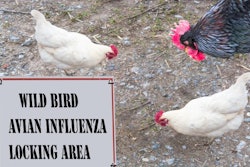
About 40,000 chickens have been culled at commercial poultry farm in Wicomico County, Maryland, after the flock was experiencing higher than normal mortality.
According to James Fisher, communications manager, Delmarva Poultry Industry (DPI), samples from the flock were submitted to the Maryland Department of Agriculture laboratory for a complete disease screening, which included testing for avian influenza.
The chickens were diagnosed with a common bacterial disease and treated. Since that time, the flock’s mortality levels have returned to normal levels, However, Fisher said, the avian influenza screening test was inconclusive, which led to the culling of the birds.
“Out of an abundance of caution, the decision was made to depopulate the birds on this farm,” he said.
For the next 14 days, there will be increasing testing and surveillance to make sure that there are no other cases of illness in poultry flocks in the area. All poultry flock owners are encouraged to follow strict biosecurity on their farms to prevent the spread of disease.
So far in 2018, there have not been any cases of avian influenza in Maryland, or in the Atlantic Flyway, where the Delmarva peninsula is located.
However, in September and October, five turkey flocks in Stanislaus County, California, were confirmed to have contracted low pathogenic H7N3 avian influenza. In late November, the California Department of Food and Agriculture (CADA) stated that those five affected premises are now free of avian influenza, but the agency still cautioned poultry owners to continue to utilize good biosecurity practices to protect their flocks.
Low pathogenic avian influenza was also recently detected in turkey flocks in Stearns and Kandiyohi counties in Minnesota. In those cases, the virus was of the H5N2 serotype.
















